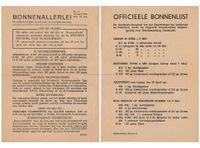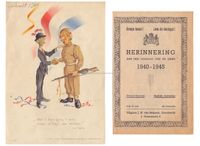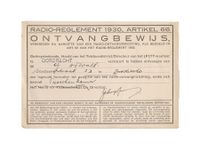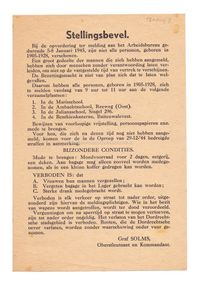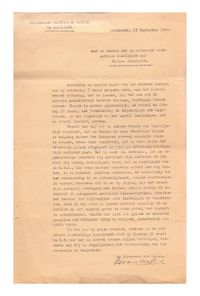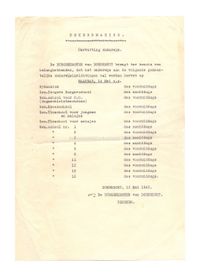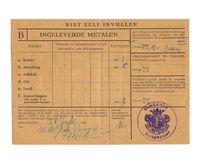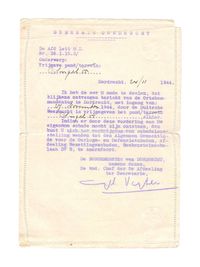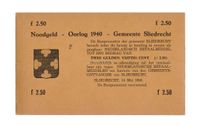Other documents.
On this page you will find additional documents regarding the occupation and liberation of Dordrecht during World War II.
Dordrecht.
Raambiljet voor de trein.
Below you can see an interesting and used poster for windows of the train. The poster was used by the Germans to prevent sabotage and espionage. This was, of course, related to the military installations such as anti-aircraft artillery that were positioned at the Moerdijk bridges.
Arbeidseinsatz document.
Below you can see a notice for reporting for the Arbeidseinsatz. The mentioned gentleman from Dordrecht was required to report to the 3rd class waiting room at Dordrecht station on January 10, 1944. From there, the person from Dordrecht would be transported to the Noordoostpolder to perform labor for the Germans. Reporting for this labor assignment was mandatory, however, many Dutch people went into hiding. The work was usually heavy, the food was poor, and individuals were treated poorly. Many Dutch men who were forced to work in labor Einsatz died from diseases, malnutrition, or as a result of combat and bombings. They were required to bring various items themselves, such as a shovel, as well as bed sheets, bicycles, utensils, and more.
"Bonnenallerlei" documents.
Below you can see three "Bonnenallerlei" documents from April 1945. The war was nearing its end, but Dordrecht was still dealing with the aftermath of the Hunger Winter. The documents were printed by the Schefferdrukkerij in Wijnstraat. They provide information about the current ration coupons, as well as general announcements. For example, there is a notice about Swiss donations. During the winter of 1945, the Netherlands received support from Sweden and Switzerland. These countries, through food transports organized by the Red Cross, aimed to alleviate the food problems faced by the thousands of Dutch people, especially in western Netherlands. Dordrecht also had significant issues with food supply. Many residents were struggling, and even the mass feeding kitchens could only provide food to the population with great difficulty. Even after liberation, obtaining groceries remained challenging. It is almost unimaginable for us today to comprehend what it means to experience hunger.
Liberation documents from Dordrecht.
Below are two liberation documents related to Dordrecht during wartime. The first is a rarely seen document titled "Met het eten ging het wel… maar oh boy die moffen" ("Food was alright… but oh boy those Krauts"). It is a printed illustration that clearly depicts the sentiments towards the Germans shortly after the liberation. The image also shows the welcoming of the English. In the top left corner of the illustration, it states: "Dordrecht 1945".
The second document is also a printed publication. It is a remembrance of the war from 1940-1945, written in rhyme or song form. There is a Dutch version along with an English translation. The document is published by J.H. van Beijnen from Dordrecht (Groenmarkt 2).
Radio documents.
Below you will find several documents related to the use of the radio. The first two documents are receipts for the declaration of radio devices. The radio regulation of 1930 - article 66 required radio owners to declare their radios. This law would later make it easy for the Germans to identify those who owned a radio during the war and ensure that they were all handed over. Only with an undeclared radio could one listen to the radio during wartime, unless the holder retained permission. Generally, these were people who worked for the Germans.
The other document is actually a German certificate of radio surrender. Starting from May 13, 1943, radio holders were required to turn in their radio devices. It was the means for the Germans to prevent Dutch people from listening to Radio Oranje or the BBC. Of course, many individuals still listened with a second radio or one that they assembled themselves.
Documents Mr. J Romijnsen.
Below you will find a comprehensive collection of documents belonging to Mr. J. Romijnsen from Dordrecht. In addition to his military documents, there are also documents related to his work at the Victoria factory. On this page, you will find the civil documents.
Johannes Romijnsen was born on August 18, 1917, in Dordrecht. He worked at the Victoria Biscuit Factory when he received a call from the mayor of Dordrecht on November 3, 1937, to report for military service on December 21, 1937. Johannes was then assigned to the 2nd Field Artillery Regiment, where he was discharged after a little over a year due to deficiencies. The exact nature of these deficiencies remains unclear, but his military service was terminated for health reasons. He spent some time at the sanatorium in Renkum. On April 8, 1939, he was granted discharge from the military camp at Oldebroek by the commander of the 2nd Field Artillery Regiment. Johannes returned to Dordrecht and resumed working at the Victoria Biscuit Factory. Various documents attest to this, including a letter from a German Hauptmann stating that Johannes was performing important work at the biscuit factory. At some point, he got married to Johanna Engels. This is mentioned in a Red Cross letter dated May 24, 1945, in which Johannes writes to his wife J. Romijnsen-Engels from Winterswijk. The reason for the Red Cross letter and his stay in Winterswijk is unknown. It is possible that Johannes was forced to work as a laborer by the Germans.
The civil documents of Johannes Romijnsen include various documents and identification cards from the Victoria Biscuit Factory. The factory was an important part of the city for many working people in Dordrecht. Later in the war, production mainly went to Germany for the needs of the war industry. The factory continued to exist for a long time after the war. In addition to these documents, there is a letter from the Wehrmacht Command Office in Dordrecht, an employer's statement for Johannes Romijnsen after he was called up for military service, and a Red Cross letter with an unknown story behind it.
The military documents of Mr. Romijnsen can be found here: Military and Mobilization.
The civil documents of Mr. Romijnsen can be found below:
Order to Report.
Below you will find an Order to Report issued by the Ortskommandant of Dordrecht. In 1945, this was Oberstleutnant Graf Solms. The order explains that many men did not show up for their forced labor. They are given one more chance to report to the designated locations. In the top right corner of the document, the date 12-01-1945 is written in pencil.
Documents related to schools in Dordrecht.
The two documents below concern schools during wartime in Dordrecht. The first document is a call addressed to the parents of Dordrecht students to send their children back to school. Despite the ongoing war, the compulsory education law remained in effect. However, many parents chose to keep their children at home due to the increasing violence, air bombings, and raids. The director of the Secondary Technical School in Dordrecht writes to the parents, expressing understanding for their concerns but also highlighting the resulting stagnation in education.
The second document also pertains to education in Dordrecht. It is an announcement dated May 12, 1945, from the newly installed Mayor Bleeker, stating that schools will reopen starting Monday, May 14, 1945. Life was gradually returning to normal after the liberation.
Proof of Metal Surrender.
Below you will find a proof of metal surrender. As the war progressed, the German war industry had an increasing need for raw materials. Metals were crucial for the production of military goods such as tanks, cannons, and ammunition. In the Netherlands as well, the occupier demanded the surrender of metals. On June 18, 1941, Reichskommissar Seyss-Inquart issued Regulation 108. This regulation required the surrender of metals such as copper, lead, bronze, tin, and other alloys to the occupier. Individuals received a monetary compensation for these metals. Although the evasion of this measure was punishable by a prison sentence of five years or a fine, the regulation was widely disregarded. The proof you see below was issued to W.J. de Voogd, residing at Cornelis van Beverenstraat 13 in Dordrecht on July 31, 1941. *1
Gent Port Pass of a Resident from Dordrecht.
Below you see a Gent Port Pass for port of Gent, issued to Mr. B. Adriaan for the ship "Bertha." With this access pass, the shipper from Dordrecht could enter the port of Gent. On the left, you see the front side of the document, and on the right, the back side. The back side of the document states that the pass is not transferable to others and that in case of loss, the port security service should be informed. Smoking is also prohibited in the port.
Exemptions for Bicycle Requisition.
Below you see three exemption documents for the requisition of bicycles. In July 1942, the German occupier requisitioned approximately 100,000 bicycles in the Netherlands for the war effort. Later on during the war, more bicycles were requisitioned by the occupier. The exemptions you see below prevented the requisition and were usually issued when someone urgently needed their bicycle for work or other important purposes. All exemptions were issued and signed by the Mayor of Dordrecht, Mr. J. Bleeker. In the photo, you can see both the front and back of the documents.
Document District Commander Evacuation of Civilian Population Dordrecht.
This card indicates who the district commander was for the evacuation of the civilian population in Dordrecht. In this case, it was Mr. Van der Wall. The card also mentions the sector commander, H. Neerings. The Bureau for Evacuation of Civilian Population, established during the war, was responsible for accommodating and taking care of evacuated civilians in case of war.
Ausweis - Mr. A. Ströhmeijer.
The document below is an Ausweis (identification paper) belonging to Mr. A. Ströhmeijer from Dordrecht. Adrianus Ströhmeijer was a member of the Dekkingsdetachement Willemsdorp, a military unit. During the war, he received this Ausweis, which granted him permission to be present at his workplace. Mr. Ströhmeijer worked as a warehouse clerk at the firm Dronkert. However, this particular document may be a forgery. On the back of the document, there is a Stalag stamp and a feldpost number. It is puzzling why these stamps were applied as Mr. Ströhmeijer was never in captivity.
Release document - Mr. van Zwijnen.
Below is a release document for the residence of Mr. van Zwijnen from Dordrecht. It pertains to the release of the property located at Singel 55, which had been occupied by the German Wehrmacht. The property was released back to the owner on November 27, 1944, as indicated in this document.
Rationing documents.
Below you can see some documents related to coupons and rationing in Dordrecht during World War II. The documents indicate the exchange value of the coupons. These documents were printed at Reidel printing press in Dordrecht.
Passierschein Zwijndrecht-Alblasserdam - Papendrecht, Zwijndrecht, 's Gravendeel, Sliedrecht.
Below you can see two Passierscheine. These documents were issued for "Polizeiliche und gerichtliche Untersuchungen" (police and judicial investigations). They were issued by the German military authority to Mr. Allard Marias Creutzberg, a person with a German name. Given that these Passierscheine were not issued indiscriminately and the recipient had a German name, it is likely that he worked for the Germans. The documents are stamped by the Wehrmachtskommandant Dordrecht.
Radio Listening Permit.
Below is a radio listening permit for a resident of Dordrecht. The permit is issued to Mr. J.M. Vuik, residing at Emmastraat 8 in Dordrecht. The radio listening permit was introduced starting from the year 1941 and was enforced by the Dutch postal and telecommunications company, P.T.T. To pay for the permit, individuals had to purchase monthly stamps that were affixed to the back of the permit. These radio stamps could be purchased at the post office. However, from May 13, 1943, most Dutch citizens were required to surrender their radios.
Train ticket Dordrecht - Moerdijk.
This document was displayed on the windows of the trains running between Dordrecht and Lage Zwaluwe. At the Moerdijk bridges, there were many bunkers, anti-aircraft defenses, and other German military installations. The Germans aimed to prevent espionage by the resistance and therefore required train passengers to keep all windows and doors closed.
Sliedrecht.
Emergency currency Sliedrecht - May 1940.
Below you can see emergency currency that was issued as a result of the events in May 1940. The emergency currency has denominations of 1 Gulden, 2.50 Gulden, and 10 Gulden, and is dated May 14, 1940. However, this emergency currency was never put into circulation. The emergency currency bears the following text: "The mayor of the municipality of Sliedrecht commands everyone to accept this proof as valid Dutch currency up to an amount of one Gulden." The 10 guilder banknote is signed by the then-mayor of Sliedrecht, Mr. H. Popping.
Lastgeving Sliedrecht - november 1944.
Below is a summons addressed to Mr. L.B. Bomers, residing at Oranjestraat 24 in Sliedrecht. The summons orders Mr. Bomers to perform guard duties at the railway on November 8, 1944, between 4 and 8 o'clock. It was issued by Mayor Dhont of Sliedrecht under orders from the German Wehrmacht. Mr. Dhont was a NSB-appointed mayor during the years 1943 to 1945.
Durchlaßschein West Nr IV/35062 – Sliedrecht – Antwerpen.
This document is a pass permit for Mr. Arie van Dijk from Sliedrecht.
It states: Arie van Dijk, foreman from Sliedrecht / Netherlands, is authorized, upon presentation of passport no. 857017, issued by the Commissioner of the Province of South Holland on November 30, 1941, to travel until February 28, 1942 via the officially designated border crossings Esschen and Putte from Sliedrecht to Hoboken near Antwerp. Issued in The Hague, on November 25, 1941.
Der Generalquartiermeister O.U.
©2017-2025 :Https://www.Dordrechtindeoorlog.nl: ( There is a copyright on the content of this website. This content is not to be shared, duplicated or published withouth the explicit permission of the author of this website. If you have any requests you can email to: Info@Dordrechtindeoorlog.nl or look on : www.dordrechtindeoorlog.nl/termsofuseforthecontentonthiswebsite.
*1 Source: www.rapportmusealeverwervingen.nl/ingeleverdemetalen.





